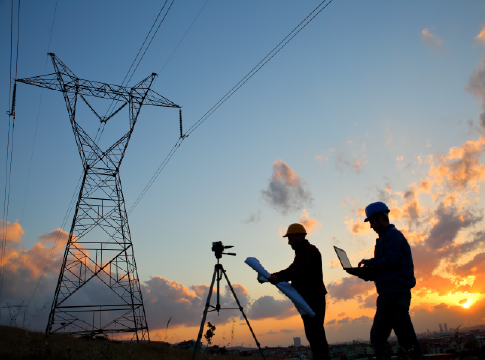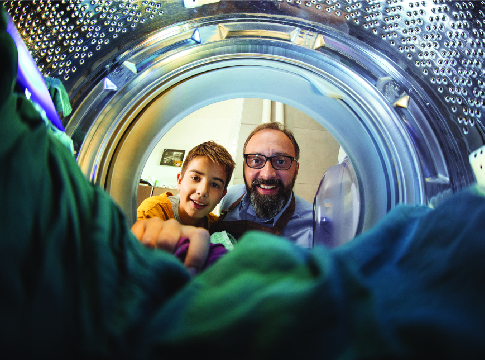Related News
Related News
-
EWEB reaffirms commitment to resilience with Wildfire Mitigation Plan approval
The utility is testing new equipment, leveraging technology, and incorporating third-party expertise to bolster electric system resiliency to a range of threats, including wildfire.
Find Out More -
Vote now for the winner of the 2025 Greenpower Grant
Get ready to cast your vote for the winner of the 2025 Greenpower Grant. EWEB is excited to announce the eligible candidates for this year's grant award! The winner of the Greenpower Grant will be voted on by Greenpower subscribers. Learn more about each origanization and their proposal before casting your vote.
Find Out More -
How EWEB’s Fleet Services reached 200,000 hours without a lost time injury
EWEB’s Fleet Services team reached a major safety milestone: 200,000 work hours without a workplace injury that results in an employee losing at least one full day of work.
Find Out More -
EWEB cuts greenhouse gas emissions from operations 55% since 2010
Switching to renewable fuels in EWEB’s fleet operations has played a key role in reducing the utility's greenhouse gas emissions.
Find Out More -
Energy conservation could offset large portion of growth in power demand
Preliminary results of an EWEB study indicate that cutting back demand can contribute to maintaining a reliable, affordable energy supply.
Find Out More -
Groups suing EWEB will burden customers with litigation-driven costs
EWEB expresses disappointment that groups choose court over collaboration and firmly disputes the claims made in the lawsuit relating to operation of the utility’s Carmen-Smith Hydroelectric Project nearly 70 miles east of Eugene. EWEB takes its environmental and public safety responsibilities seriously. Contrary to the assertions in the lawsuit, construction of fish passage was postponed because EWEB’s regulator, the Federal Energy Regulatory Commission (FERC), required the utility to study and resolve urgent dam safety issues first.
Find Out More -
EWEB offers Greenpower Grant to support local sustainability project
The Greenpower Grant, funded by voluntary customer subscriptions to Greenpower, not customer grants, supports projects that advance renewable energy, clean energy education or efforts to reduce or offset local carbon emissions.
Find Out More -
Rising Together: Female operation staffers begin industry mentorship program
One week into Women's History Month and just before International Women's Day on March 8, three women in EWEB leadership roles embarked on a 10-month-long journey of mentorship, fellowship, and professional development.
Find Out More -
EWEB and BRING cook up new ways to help Eugene businesses save energy
Businesses can cut energy costs with EWEB’s free Energy Assessments and efficiency programs. Plus, for a limited time, BRING is offering $1,000 rebates for qualifying upgrades—apply by Feb. 28!
Find Out More -
EWEB Board Adopts 2025 Goals
Goals focus on supporting low-income community members and renters, while improving operational efficiency.
Find Out More -
PNW Lineman Rodeo raises $85,000 for Oregon Burn Center
EWEB line techs are proud partners and participants in the rodeo fundraiser every year.
Find Out More -
Eugene residents share energy and water saving tips
From blocking a draft to replacing your heating system, each action you take can save water and electricity.
Find Out More -
Energy demand reaches highest level in nearly a decade as utility prepares for ice
Frigid temperatures in the low 20s caused surging electricity demand in early February.
Find Out More -
EWEB leverages Oregon Clean Fuels Program to support electric mobility
Five grants support programs benefiting homeless youth and bike sharing, among others.
Find Out More -
Frigid weather drives highest energy demand of the winter so far
Peak electricity demand this season surpasses demand levels during last year’s ice storm.
Find Out More - Show More
EWEB seeks public input on electric vehicle, demand response standards
October 11, 2023 • Aaron Orlowski, EWEB Communications

EWEB is seeking public input on the potential adoption of updated standards for electric vehicles (EVs) and demand response programs.
Interested community members can comment online by visiting eweb.org/PURPA. The deadline for comment is Oct. 14.
The standards EWEB is weighing come from updates to the federal Public Utility Regulatory Policies Act (“PURPA”). The legislation does not require public utilities such as EWEB to adopt the standards, in whole or in part. Rather, the law requires EWEB to evaluate the standards and decide whether they are a good fit.
The potential standards encourage greater adoption of electric vehicles and implementation programs to shift when electricity is consumed. They broadly align with EWEB’s current policies and programs supporting the electrification of the transportation sector. And they align with EWEB’s goals of implementing demand response programs that incentivize customers to shift when they use energy – through smart thermostats, managed EV charging and other methods – to reduce strain on the grid and reduce carbon emissions.
“The standards proposed by PURPA form a strong foundation, but we will need to clarify and adjust them to align with our community’s values,” said Brian Booth, EWEB’s chief energy resource officer. “We broadly support reducing community carbon emissions by electrifying transportation with EWEB’s largely carbon-free electricity. And we support using demand response programs to reduce energy use at peak times, when it tends to cause the most emissions and be the most expensive.”
The proposed electric vehicle standards align with existing EWEB programs.
The potential standards state that utilities should promote transportation electrification by establishing rates that promote “affordable and equitable electric vehicle charging options for residential, commercial, and public sector electric vehicle charging infrastructure” while improving the customer experience by reducing charging times. They also state that utilities should accelerate third-party investment in EV charging and “appropriately recover the marginal costs” of delivering electricity to EVs.
EWEB currently has robust programs to promote transportation electrification, including a $500 rebate for Level 2 home EV chargers, a $300 electric bike rebate, EV car sharing stations, and electric mobility grants for community organizations and others. For businesses, EWEB offers up to $1,500 for public commercial Level 2 chargers, up to $2,000 for public multifamily Level 2 chargers and up to $15,000 for public commercial direct current fast chargers. The funds for these programs come from Oregon Clean Fuels Credits, not EWEB rates.
For EWEB, electric mobility extends beyond customers owning their own electric vehicles to include walking, biking, riding e-bikes, transit and electric car share programs. This diversity of options makes electric mobility more accessible and equitable.
As EWEB weighs the PURPA standards, it will have to navigate tradeoffs. Tension exists between increasing charging speeds and making charging affordable, since faster charging tends to be more expensive to deliver. In addition, tension also arises between recovering the marginal costs of delivering electricity to EVs and setting equitable rates.
“A key consideration in the proposed standards is how equity manifests. We’ll have to navigate tensions and tradeoffs between various priorities,” said Juan Serpa Muñoz, who manages EWEB’s electric mobility programs. “To guide us, we’ll keep ensuring that EWEB’s programs are designed to make electric transportation accessible – not merely available – to all customers, including those who can’t afford a personal vehicle.”
The proposed demand response standards match EWEB’s vision for future programs.
The potential standards state that utilities should “promote the potential use of demand response and demand flexibility practices by commercial, residential, and industrial consumers to reduce electricity consumption during periods of unusually high demand.” They also state that utilities “may establish rate mechanisms for the timely recovery of the costs of promoting demand-response and demand flexibility.”
Demand response programs arose as a potentially vital way to meet the community’s future electricity needs during EWEB’s analytical 2023 Integrated Resource Planning (IRP) process. EWEB’s IRP modeling software selected demand response as a cost-effective resource that can reduce the need to build or buy new power plants to provide electricity when demand is at its highest.
Before EWEB can fully adopt demand response programs, the utility will need to finish deploying advanced metering infrastructure, or “smart meters.” So far, EWEB has installed smart meters free of charge for about 70% of customers, though supply chain shortages of the last few years have delayed rollout. With inventory rising again, EWEB expects to begin replacing the remaining old meters with smart meters early next year.
“Technology improvements in smart thermostats, smart hot water heaters, smart EV chargers and other devices are making possible a world where customers play a key role in managing their energy use so it better lines up with when renewables such as wind and solar are abundant,” said Brian Booth, EWEB’s chief energy resource officer. “But to make this future a reality at EWEB, we need to finish rolling out smart meters and upgrading our back-end billing system, while implementing the right rate structures and pricing signals.”
The mid-August heat wave demonstrated the potential for demand response in the Eugene community. With temperatures cresting 100 degrees for four days straight, EWEB asked customers to cut back on energy usage to avoid straining the grid. Customers responded enthusiastically, trimming energy use by 10 to 15 megawatts – the equivalent of shutting off 10,000 to 15,000 window air conditioning units.
The community’s voluntary conservation – customers raised the temperature settings on their air conditioners, while delaying electric vehicle charging and the use of major appliances – shows that the community is ready for demand response programs that would encourage customers to shift when they use energy to better align with when energy is abundant and available.
The PURPA standards reflect federal energy goals.
The Public Utility Regulatory Policies Act (“PURPA”) was first passed in 1978 and was updated as part of the 2021 Infrastructure Investment and Jobs Act. It requires public utilities such as EWEB to consider the standards, but it does not require public utilities to adopt them.
PURPA was originally passed to promote energy conservation and the efficient use of resources, as well as to provide equitable rates to customers.
The new demand response standard reflects a subtle change in the purpose of PURPA. In the 1970s, electricity generators relied on fossil fuels. So conserving fuel – regardless of when it was burned – was the main concern.
Today, electricity generators are increasingly variable renewable resources, such as wind and solar. The “fuel” – the wind and the sun – is cheap and plentiful. But the challenge is aligning energy consumption with when that “fuel” is available. This is why the new standards focus on demand response programs, which shift when energy is consumed.
Related Programs
EWEB’s Integrated Resource Plan (IRP) will analyze possible energy resource portfolios with a goal of creating useful insights for long-term (20-year) electricity supply planning decisions.




